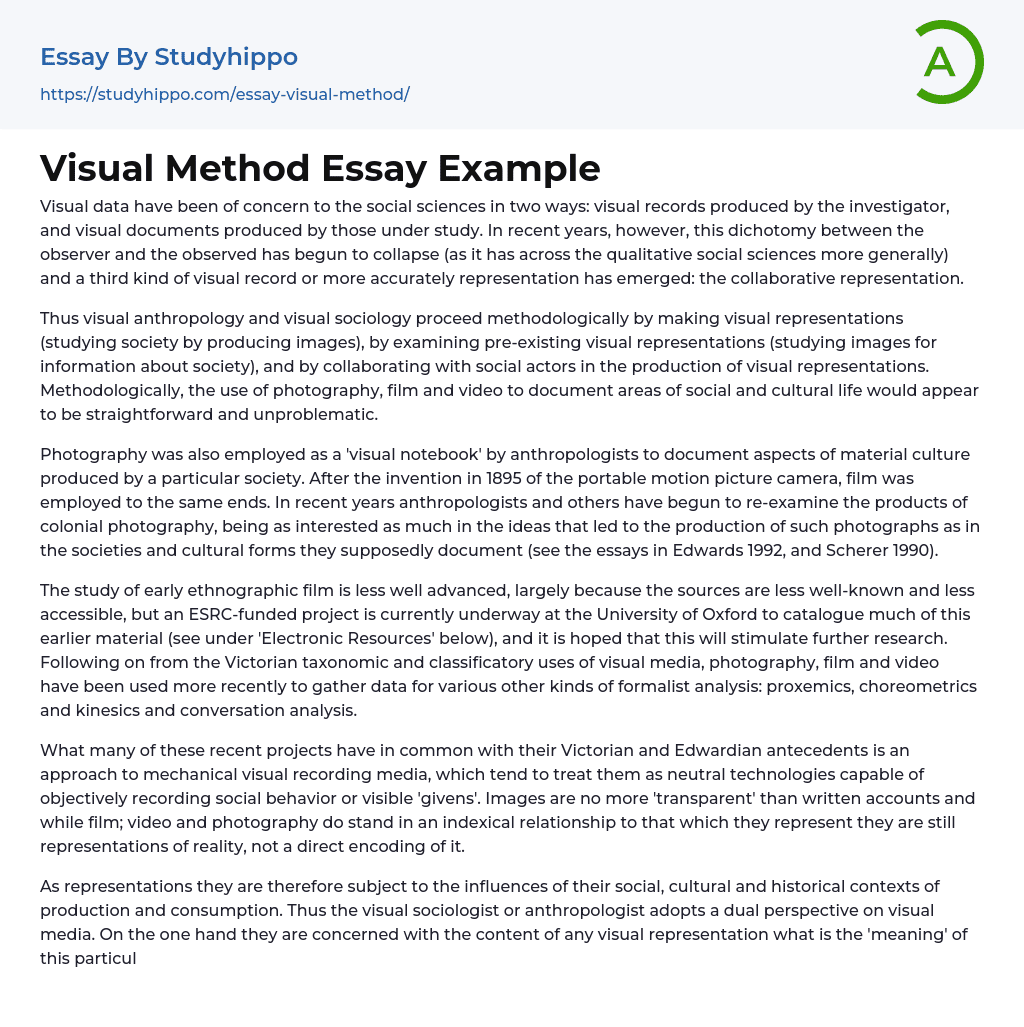The visual records of investigators and the visual documents created by those being studied have received considerable attention in the social sciences. However, a recent development has blurred the line between researchers and subjects, resulting in a new form of visual record known as collaborative representation.
Both visual anthropology and visual sociology employ different approaches to examine society through visual representations. These approaches involve generating new images, evaluating existing images, and collaborating with individuals in developing visual representations. The utilization of photography, film, and video for documenting social and cultural aspects may appear straightforward and devoid of methodological complexities.
Anthropologists have also employed photography to document the material culture of particular societies. The introduction of portable motion picture cameras in 1895 enabled film to serve the same func
...tion. In modern times, anthropologists and others have begun reevaluating photographs captured during the colonial era, with an emphasis on comprehending the concepts that shaped their production rather than solely studying the depicted societies and cultures (see essays in Edwards 1992 and Scherer 1990).
The University of Oxford is currently conducting a project, funded by the ESRC, to organize and document early ethnographic film research with the goal of stimulating further research in this field (see 'Electronic Resources' below). In addition to their use in formalist analysis methods like proxemics, choreometrics, kinesics, and conversation analysis, visual media such as photography, film, and video were also used for taxonomic and classificatory purposes during the Victorian era.
The modern approach to mechanical visual recording media, seen in many recent projects, is similar to that of Victorian and Edwardian predecessors. These projects view these technologies
as impartial tools that can objectively capture social behavior and visible 'givens'. However, it is crucial to acknowledge that images, like written accounts, are not naturally 'transparent'. While film, video, and photography do have a direct connection with the subjects they portray, they are still representations of reality rather than a direct encoding.
Visual media, including representations in art and photography, are shaped by their social, cultural, and historical contexts throughout their creation and consumption. This necessitates visual sociologists and anthropologists to take on a dual perspective. They examine the content of visual representations, such as deciphering the significance of particular design elements on artworks or recognizing individuals captured in photographs.
When scholars analyze visual representations created by others, they examine the art object's context and content, such as its producer and intended audience. They also investigate the reasons behind capturing a particular photograph and its preservation. However, when investigators produce their own visual representations, there is a risk of prioritizing content over considering the context.
The emergence of the 'direct cinema' movement in the 1960s aimed to expose behind-the-scenes aspects of filmmaking in documentary film. This approach, influenced by Barnouw (1974), Rosenthal (1988), and Loizos (1993), intentionally included filmmakers' equipment or even themselves within the frame. These concepts were also adopted in ethnographic film practices to create a stronger connection between human subjects and viewers. In contrast, achieving more introspective or contemplative portrayals with still photography may be slightly more challenging.
In his work, Doug Harper, a visual sociologist, has successfully combined text and image to provide commentary on each other (Harper 1987; see also Berger and Mohr 1975). It
is crucial to acknowledge that visual representations are created and consumed within a social context, which resembles representations found in television and cinema for film and video.
When attending a screening, audience members have certain expectations concerning the narrative form, plot development, and composition quality. These expectations may be unconscious or vague but are still present. It's worth noting that a film can be interpreted in various ways and shouldn't be limited to just one reading. Stuart Hall, a sociologist, has discussed the concept of "preferred readings" in films (Hall 1977), while an anthropological study on ethnographic films shown to students challenges the belief that such films promote empathy and bridge the gap between oneself and a drastically different culture (Martinez 1990).
- Population essays
- Cultural Assimilation essays
- Demography essays
- Ethnographic essays
- Population Growth essays
- Animals essays
- Charles Darwin essays
- Agriculture essays
- Archaeology essays
- Moon essays
- Space Exploration essays
- Sun essays
- Universe essays
- Birds essays
- Horse essays
- Bear essays
- Butterfly essays
- Cat essays
- Dolphin essays
- Monkey essays
- Tiger essays
- Whale essays
- Lion essays
- Elephant essays
- Mythology essays
- Time Travel essays
- Discovery essays
- Thomas Edison essays
- Linguistics essays
- Journal essays
- Chemistry essays
- Biology essays
- Physics essays
- Seismology essays
- Reaction Rate essays
- Roman Numerals essays
- Scientific Method essays
- Mineralogy essays
- Plate Tectonics essays
- Logic essays
- Genetics essays
- Albert einstein essays
- Stars essays
- Venus essays
- Mars essays
- Evolution essays
- Human Evolution essays
- Noam Chomsky essays
- Methodology essays
- Eli Whitney essays




